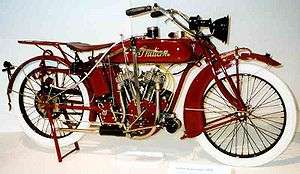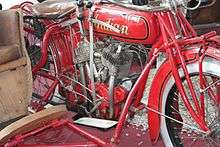Indian Powerplus
 1920 Indian Powerplus with Cradle Spring Frame | |
| Manufacturer | Hendee Manufacturing Company |
|---|---|
| Also called | Indian Standard (1923-1924)[1] |
| Production | 1916-1924 |
| Assembly | Springfield, MA, USA |
| Predecessor | 1913-1916 Indian V-Twin |
| Successor | Indian Chief |
| Class | Heavyweight standard |
| Engine | Four-stroke 42° flathead V-twin engine (see engine infobox below) |
| Transmission | 3-speed gearbox, hand shifter, hand and foot clutch controls[2] |
| Suspension |
Front: Trailing-link fork with leaf spring Rear: either rigid (as standard) or by swingarm linked by struts to leaf springs (with optional Cradle Spring Frame)[1] |
| Brakes |
Front: none Rear: internal expanding drum, external band brake[2] |
| Weight | 430 lb (200 kg)[2] (wet) |
| Fuel capacity | 2.5 US gal (9.5 L)[2] |
| Related | 1913-1916 Indian V-Twin (frames, transmission, clutch, tanks, fenders)[3] |
| Indian Powerplus engine | |
|---|---|
|
| |
| Overview | |
| Manufacturer | Hendee Manufacturing Company |
| Production |
|
| Combustion chamber | |
| Configuration | 42° V-twin |
| Displacement | |
| Cylinder bore | |
| Piston stroke | |
| Cylinder block alloy | cast iron |
| Cylinder head alloy | cast iron |
| Valvetrain | flathead |
| Combustion | |
| Fuel type | petrol |
| Cooling system | air cooled |
| Chronology | |
| Predecessor | Indian F-head V-Twin |
| Successor | Indian Chief engine |
The Indian Powerplus is a motorcycle that was built from 1916 to 1923 by the Hendee Manufacturing Company. Designed by Charles Gustafson, the Powerplus's engine was Indian's first flathead.[4]
Origin
Charles Gustafson left Reading Standard in 1909 and joined Indian as Oscar Hedstrom's assistant.[5][6] Gustafson had designed side valve "flathead" engines for Reading Standard, which had been the first motorcycle manufacturer in the United States to use a flathead engine in a production motorcycle.[5] When Hedstrom left Indian in 1913, Gustafson became Indian's chief engineer.[4]
In late 1915, Indian introduced Gustafson's replacement for Hedstrom's 61-cubic-inch (1,000 cc) V-twin engine.[4] The new engine used side valves instead of the inlet-over-exhaust (IOE) valve layout used in Hedstrom's designs.[2][4] The flathead engine was quieter and less expensive to manufacture than the earlier IOE engine and needed less maintenance. It was named "Powerplus" because its output of approximately 16 horsepower (12 kW) was noticeably greater than that of the earlier engine.[4]
The new engine was installed in the existing frames for Indian V-twin motorcycles, and used existing drivetrain components, tanks, handlebars, and other components.[3] The drive train included a clutch, a kickstarter, and a three-speed gearbox.[2][4]
The standard frame for the Powerplus had a conventional rigid rear wheel mounting, but the Powerplus was also available with Indian's Cradle Spring Frame.[1] Introduced in 1913, the Cradle Spring Frame had a rear swingarm linked to trailing leaf springs.[7]
Controls

The Powerplus had twist grips on both handles; the throttle was controlled by the left twist grip while the right twist grip advanced or retarded the spark. Three controls were on the right side of the gas tank, a vertically-operated shifter, an exhaust valve lifter, and a hand clutch lever. The clutch lever was linked to the clutch pedal positioned on the left side of the bike.[2]
Promotion and development
Between 24 and 28 August 1915, Erwin "Cannonball" Baker rode an early Indian Powerplus from Vancouver to Tijuana in 3 days, 9 hours and 15 minutes, establishing a new "Three Flags" record.[8]
The Powerplus engine was revised in 1917 with the barrels and pistons lengthened by a quarter of an inch and the piston wrist pin relocated below the piston center. This was done to reduce the occurrence of piston slap. The valve caps in the cylinder head were finned from 1917 until the end of production.[3]
A larger engine, with a displacement of approximately 72 cubic inches (1,180 cc), became available in 1920.[3]
End of production
Production of the larger Powerplus engine ended in 1922, the year in which production of the Powerplus's eventual successor, the Chief, began production.[1] The Powerplus was renamed the "Standard" in 1922, reflecting the fact that it was not as powerful as the Chief.[1][9]
The Standard was discontinued in 1923, and the Cradle Spring Frame was discontinued with it.[10] Indian would not offer rear suspension on a production motorcycle again until 1940, when the Chief and the Four would be given plunger suspension.[11]
References
- Citations
- 1 2 3 4 5 6 Williams 2012, p. 3.
- 1 2 3 4 5 6 7 8 9 10 Williams 2012, p. 1.
- 1 2 3 4 5 6 7 Williams 2012, p. 2.
- 1 2 3 4 5 6 Girdler, Allan, The Harley-Davidson and Indian Wars, p. 49
- 1 2 "National Treasures — 1909 Reading Standard", Motorcycle Classics
- ↑ Girdler, Allan, The Harley-Davidson and Indian Wars, p. 42
- ↑ Girdler, Allan, The Harley-Davidson and Indian Wars, pp. 22-23
- ↑ Motorcycle Illustrated, pp. 19, 21, Motorcycle Publishing, 1915
- ↑ Girdler, Allan, The Harley-Davidson and Indian Wars, pp. 69-70
- ↑ Girdler, Allan, The Harley-Davidson and Indian Wars, p. 70
- ↑ Hatfield, Jerry, Standard Catalog of American Motorcycles 1898-1981: The Only Book to Fully Chronicle Every Bike Ever Built p. 347
- Sources
- Girdler, Allan (2002) [1997]. The Harley-Davidson and Indian Wars. St. Paul, MN US: Motorbooks International Publishing. ISBN 0-7603-1353-9.
- Hatfield, Jerry (2006-02-08). "I". Standard Catalog of American Motorcycles 1898-1981: The Only Book to Fully Chronicle Every Bike Ever Built. Iola, WI USA: Krause Publications. p. 347. ISBN 978-0-89689-949-0. LCCN 2005922934. Retrieved 2014-04-27.
- Williams, Greg (2012), "Indian Powerplus — Plus", Motorcycle Classics, Ogden Publications (May/June), retrieved 2013-03-27
- "1909 Reading Standard". Motorcycle Classics. Topeka, Kansas, USA: Ogden Publications. 2011-07-19. Retrieved 2014-04-26.